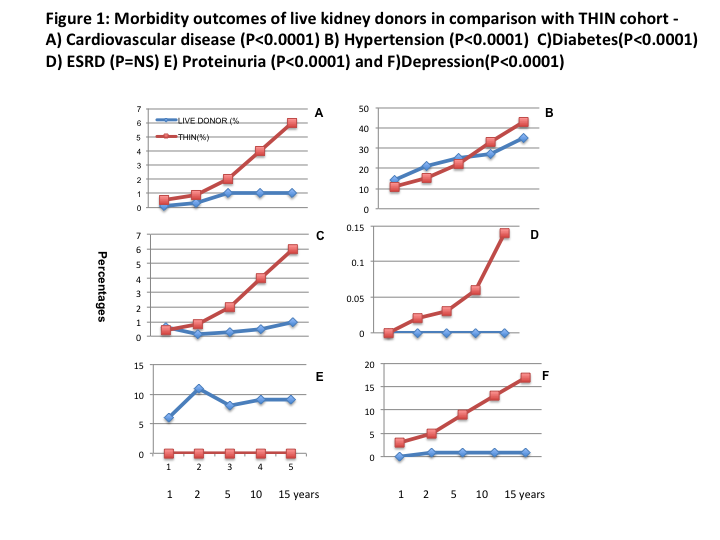Comparative Morbidity Outcomes in Live Kidney Donors in the UK: 15 Year Cohort Study
Nithya Santhana Krishnan1,2, Lisa Mumford3, Graham Lipkin4, Simon Fletcher1, Indranil Dasgupta5, Paramjit Gill6, Ronan Ryan7, Neil Raymond8.
1Renal Unit, University Hospitals Coventry & Warwickshire NHS Trust, Coventry, United Kingdom; 2Faculty of Health and Life Sciences, Coventry University, Coventry, United Kingdom; 3Statistics and Clinical Studies, Organ Donation and Transplant, National Health Services Blood and Transplant, Bristol, United Kingdom; 4Renal Unit, University Hospitals Birmingham, Birmingham, United Kingdom; 5Renal Unit, Birmingham Heartlands Hospital, Birmingham, United Kingdom; 6Unit of Academic Primary Care, University of Warwick, Coventry, United Kingdom; 7Primary Care, Primary Care, West Midlands, Brmingham, United Kingdom; 8Statistics, University Hospitals Coventry & Warwickshire NHS Trust, Coventry, United Kingdom
Living kidney donation has significantly improved recipient and graft survival world wide. With a move to increase these numbers further, it is increasingly important to understand clearly the outcomes and risks associated with kidney donation.
Aim: To investigate longer term morbidity outcomes of U.K live kidney donors (LD) compared to with a healthy controls.
Methods: Ethics approval was already in place to accrue data from datatbase. Study protocol was reviewed and passed by Renal Registry projects advisory group, and an independent scientific review committee, before release of the data. Cohorts for Study: A) Live Donors (LD) dataset: Dataset obtained from the UK Transplant Registry held by National Health Service Blood and Transplant, U.K. All live kidney donors from January 1st 2001 to 31st December, 2013 included and the end date was 31st December 2016 . B) Comparative Cohort, The Health Improvement Network (THIN) database : This is a large UK general practice database which contains anonymized longitudinal patient records from over 500 practices. Data from THIN was collected stratified by age, gender and year of entry to provide a comparative cohort excluding a number of baseline conditions that would have been a contraindication to donation.
Results:

Table 1 shows baseline characteristics of LD and THIN. Figure 1 shows statistically significant increase in cardiovascular disease, diabetes and depression in the THIN cohort, and proteinuria in the LD group. Hypertension, though significantly higher in the LD group in the initial years, after seven years was significantly lower, possibly due to healthy lifestyle, regular follow up and early intervention. There were no cases of end stage renal disease (ESRD) in the LD group whereas 17 cases in THIN (P=0.01). Extending the analysis to include eGFR <30, there were 8 cases in the LD group when compared to 94 in THIN (P<0.001).

Conclusions: Though hypertension was significantly more common in the LD group in the early years when compared with a healthy matched cohort, the prevalence of hypertension after about seven years was lower in the LD group. In this analysis live kidney donors seemed to have better long term health outcomes than matched controls.
Warwickshire Private Hospitals Charity Fund. Coventry Kidney Research Fund.
